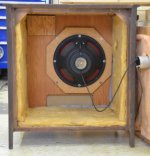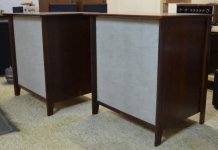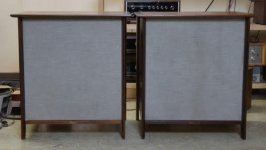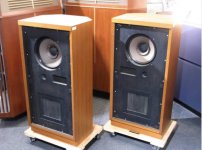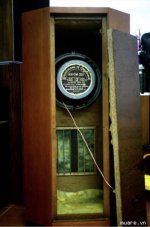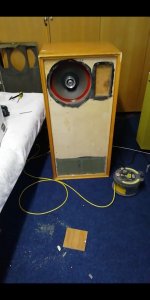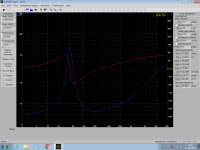
This is the other driver measurements. The added mass was 135g this time so 1g off, either way the results seem to match. I believe these drivers were hardly used GM they seem almost brand new probably need to be broken in and used.
* This data was exported from the Dayton Audio Test System: DATS
*
* Piston Diameter = 279.4 mm
* f(s)= 41.05 Hz
* R(e)= 7.182 Ohms
* Z(max)= 65.94 Ohms
* Q(ms)= 5.069
* Q(es)= 0.6196
* Q(ts)= 0.5521
* V(as)= 264.8 liters (9.352 cubic feet)
* L(e)= 1.133 mH
* n(0)= 2.819 %
* SPL= 96.6 1W/1m
* M(ms)= 29.97 grams
* C(ms)= 0.502 mm/N
* BL= 9.466
* K(r)= 0.1625
* X(r)= 0.4305
* K(i)= 0.01968
* X(i)= 0.6305
*
Attachments
Last edited:
Thanks! Sure seems that way, what with its high efficiency and especially if coupled to a high output impedance tube amp and likely would never break in if used as a [family] room/whole house ~Muzak system like was common [at least in the USA] till hard rock[abilly] came along [not so much Elvis or even the Beatles, but CCR, Pink Floyd, et al].
That said, I remembered having a list of randomly measured drivers dating from back in '71 when T/S was starting to become known to the general public and lo n' behold got close [or so I assumed] with 120FR [CK], 120W woofers, but the specs are so incredibly far off from yours [and each other!] made me wonder, though were measured with a < 30 Hz Fs and otherwise not surprised of these 'world's apart' specs either, so once [re]broken in could in theory drop this much. Then again, the secondary surround may not let it, but 'hope springs eternal'. 😉
This also made me take a look at the DATS screen and immediately saw a potentially major problem depending on how the DATS is programmed, i.e. what all does it use the inputted Piston Diameter for as it's way off? He asks rhetorically since they will need to be remeasured to find out. 🙁
Browse this T/S tutorial to see how much effective piston area [Sd] impacts specs: Thiele Small parameters equations - How each one affects the others
11" is wide enough for some 15" with < 10" [9.7"/9.6"] for a 12" frame being the norm for this style surround plus will be even shorter once at least half of the center surround is subtracted.
GM
Vintage published specs: ASHLEY
That said, I remembered having a list of randomly measured drivers dating from back in '71 when T/S was starting to become known to the general public and lo n' behold got close [or so I assumed] with 120FR [CK], 120W woofers, but the specs are so incredibly far off from yours [and each other!] made me wonder, though were measured with a < 30 Hz Fs and otherwise not surprised of these 'world's apart' specs either, so once [re]broken in could in theory drop this much. Then again, the secondary surround may not let it, but 'hope springs eternal'. 😉
This also made me take a look at the DATS screen and immediately saw a potentially major problem depending on how the DATS is programmed, i.e. what all does it use the inputted Piston Diameter for as it's way off? He asks rhetorically since they will need to be remeasured to find out. 🙁
Browse this T/S tutorial to see how much effective piston area [Sd] impacts specs: Thiele Small parameters equations - How each one affects the others
11" is wide enough for some 15" with < 10" [9.7"/9.6"] for a 12" frame being the norm for this style surround plus will be even shorter once at least half of the center surround is subtracted.
GM
Vintage published specs: ASHLEY
Last edited:
Then you must be right: the data are bad.If the data is good,It looks more like an instrument or pa speaker, rather than a hi-fi woofer.
My Stephens 150W (15-inch) was within a few Hz's of stock spec (about 22 Hz) after 50+ yrs (and maybe spot on, had I measured the resonance back then).
Beats me why low resonance drivers are harder to find today when the resonance pretty much defines the low-end reach.
(OK, the reason is so manufacturers can have heavy voice coils and claim the same power handling capacity as my kitchen toaster.)
As far as sealed boxes, the bigger the better and I'll stick with that.
B.
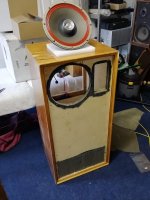
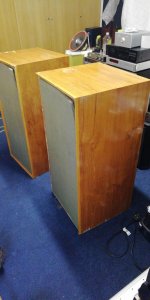
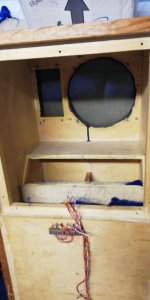
Well guess i got to do it the old school way of just using my ears and what i have available.
Pair of folded horn enclosures which i got really cheap, were built by a BBC engineer, originally houses some decca tweeters and goodmans axiom 301's.
Have to rebuild them but for testing purposes the Trusonics will fit straight in and i can do some listening and use REW to do some analysis.
With the overwhelming effect of room acoustics, etc. on the final sound hardly worthwhile obsessing about planning every detail. Use REW and see what you have (testing drivers/speakers individually with no XO but at low power*) and use DSP to get what you want.
B.
* the woofer should be great but only guessing how that fancy tweeter will work today; unlikely you'll want to keep whatever thingy Stephens used as a crossover
B.
* the woofer should be great but only guessing how that fancy tweeter will work today; unlikely you'll want to keep whatever thingy Stephens used as a crossover
Well guess i got to do it the old school way of just using my ears and what i have available.
So not going to remeasure with smaller piston diameter?
GM
Yes will do GM, just want to put these in an enclosure and hear them, as for the piston diameter I followed the dayton online video.
I pretty much measured what they asked which was actually the cone diameter, why they called it piston diameter in not sure.
I didn't measure from the basket just from the outside rim of the surround(apex of the surround) which was 11".
I'll measure from the basket rim and do the measurements again, I'll also try different weights for the mass.
Where will this all lead though, will the results lead me to designing a suitable enclosure based on the measurements?
YouTube
See the parts express how to video
I pretty much measured what they asked which was actually the cone diameter, why they called it piston diameter in not sure.
I didn't measure from the basket just from the outside rim of the surround(apex of the surround) which was 11".
I'll measure from the basket rim and do the measurements again, I'll also try different weights for the mass.
Where will this all lead though, will the results lead me to designing a suitable enclosure based on the measurements?
YouTube
See the parts express how to video
Hmm, they're apparently making the assumption that since it's a tiny signal that it won't move enough to be considered shorter than when measured flat between the gaskets with no holes rather than effective diameter based on [Sd], which will make it narrower, putting it ~ in the middle of the surround and in this driver's case, omitting the same [Sd] for the tweeter and its surround, so at the very least it seems like the tweeter's diameter should be subtracted from the 11".
Regardless, it converts the diameter to m^2, so to my way of thinking this must be the same as its Sd [effective piston area], making my way to get the PD a lot more accurate, though without doing the math not sure how much difference it makes to the specs beyond efficiency.
edit: note that ideally the amount of added mass required will lower Fs by 1.56x [Fs*0.641] and due to its construction put it evenly distributed around the inner surround's point of attachment to the cone.
GM
Regardless, it converts the diameter to m^2, so to my way of thinking this must be the same as its Sd [effective piston area], making my way to get the PD a lot more accurate, though without doing the math not sure how much difference it makes to the specs beyond efficiency.
edit: note that ideally the amount of added mass required will lower Fs by 1.56x [Fs*0.641] and due to its construction put it evenly distributed around the inner surround's point of attachment to the cone.
GM
Last edited:
All good points, ok back to the drawing board to add these little details in, you're right about the cone size and subtracting the size of the tweeter. I Will have another go, I think I'll start searching for some one or a company close by that can do this for me!
Take a driver with known T/S values and see how well your tool works. Do it twice.
Part of sensitivity analysis is knowing what measurements have the big influence. It may be that a certain measurement that can only be done crudely is also a measurement that is quite definitive. Just saying'.
Or just mount it and see what you got. That's where I'd start.
B.
Part of sensitivity analysis is knowing what measurements have the big influence. It may be that a certain measurement that can only be done crudely is also a measurement that is quite definitive. Just saying'.
Or just mount it and see what you got. That's where I'd start.
B.
I have a few drivers with known TS parameters I will give them a test and see what the device comes up with.
Ah, my old heart goes pitta-patta just to see that beautiful driver.
Funny, that accordion surround is really great and has less drag than the "new-and-improved" stiff rubber ones. Hence, the parameter that matters the most to me is resonance because that constrains how low you go and your fine old driver will go pretty low.
(Yes, there are debates about surrounds. But stiffness is not debated and that's all I'm saying.)
B.
Funny, that accordion surround is really great and has less drag than the "new-and-improved" stiff rubber ones. Hence, the parameter that matters the most to me is resonance because that constrains how low you go and your fine old driver will go pretty low.
(Yes, there are debates about surrounds. But stiffness is not debated and that's all I'm saying.)
B.
For sale Stephens Trusonic 120 CX speakers and cabinets
This seems to be an enclosure designed by trusonic for this speaker.
This seems to be an enclosure designed by trusonic for this speaker.
Possibly a BR with classic Olson tuning. 1960's: I was there and the boxes were lousy, Bozak, Klipsch, and some few others* possibly excepted. Mostly guesswork and ten-cents of cotton damping (what was that stuff called?).
Look how low the tweeter would be. Not quite as flimsy as some boxes.
But the Stephens drivers were great and still are.
B.
* Karlson??????
Look how low the tweeter would be. Not quite as flimsy as some boxes.
But the Stephens drivers were great and still are.
B.
* Karlson??????
Last edited:
These boxes and drivers are really old school and likely to be high eff and restricted bass extention,A real retro sound. Is that what your aiming for?????
John I'm just playing around at the moment until I am certain of getting some good TS measurements or someone has a enclosure design that is recommended.
Yup pre T/S it was largely done by ear I used to have a lot of info on 40s-60s enclosure design.Conclusion >>>trial and error largely.
- Status
- Not open for further replies.
- Home
- Loudspeakers
- Multi-Way
- Stephens Trusonic 120cx speakers - Best type of enclosure design?
